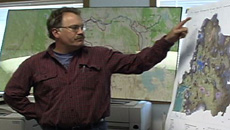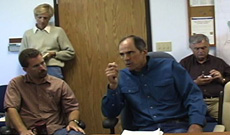KBC Home
Tour Table
of Contents
o Klamath Basin Ecosystem Restoration
Karas: Okay, thank you very much, we're getting a little short on time. Dave, were you going to give us a little spiel?
 |
Dave Ross, restoration biologist: I just wanted to give a quick spiel on the restoration program. The Klamath Basin Ecosystem Restoration office was started here in Klamath Falls in 93 and we started doing habitat restoration projects in 94. This map represents where the location of all those projects at least thru 2002 are located. The program has been operated pretty much as an interagency type of set up with the Bureau of Reclamation, BLM, and Forest Service. Weíve done probably over 300 projects throughout the basin on both private lands and public lands over this period of time. Weíve had a variety of funding sources. Weíve had the Partners for Fish and Wildlife which is a national restoration program run by the service. |
The one we're currently, a larger pot of money if you will, the Hatfield pot of money is currently being used. In the past weíve had, Bureau of Reclamation has had ORCA; we no longer have that pot of money. Jobs in the Woods, this coming year will be the last year that weíll receive funding from that, so my point here is at least on the Fish and Wildlife Service weíve lost over 60% of our funding in the last two years.
From the private landowner side weíve done a variety of projects, everything from wetland restoration, riparian restoration. like repairing pastures, repairing fencing, to upland projects: clearing juniper to restore grassland habitats and sage bush habitats. In the early years we probably had more money then we had good projects. Itís reversed. We have so many more landowners than we could provide funding to. A good example would be in the Sprague and Sycan Rivers, we probably have well over 15 landowners that will restore over 30 miles of stream, but we donít have the funding to do that. So I am anticipating with open arms the CIP program to provide all the funding and solutions if you will to this process. Some of the real recent changes that have been really exciting, you know all the controversy of water verses fish and fisherman, and farmers, and all that it is real exciting to see a lot of people working together. A good example of this would be the Lake Side farms, which Dr. Gerhardt was involved with, but one of the persons who owns that property was involved in the infamous headgate opening operation a couple of years ago, but here is a good example of local land owners, agricultural landowners, that are willing to lend themselves for local solutions, and in that project, which is located right above Klamath Falls, about Iíd say 60 or 70% of the project or the ownership is still in agricultural production. Whereas smaller acreages are being restored to wetlands whereby theyíll run the irrigation water through the wetlands and then pump it back out to the lake.
| Curt Mullis, Klamath Basin Ecosystem Restoration Project Leader: I want to add one thing, two things. What you have just described Dave, I consider a major and significant recovery effort thatís been going on in the last ten years here, including federal, state, and private efforts, so I would offer that in contrast to Danís comment earlier about no recovery actions or efforts are being implemented in the basin here, and of course we are looking forward thru possibly FERC relicensing, tribal settlement, and especially the CIP, very much enhanced opportunities financially for restoration, and as Dave says, there is a lot of interest in private land owners in watershed restoration. |  |
So I think we can look forward with optimism to the very near future. The other thing I wanted to mention was a gentleman that helped found this office in 1993 by the name of Dr. Ron Garrett,. Ron Garrett has worked at Humboldt State on several occasions and worked in this office and came up with a idea about 5 or 6 years ago while he was still employed here of a brain trust, including the area universities much like what we're talking about right here today. So my hatís off to Ron for one of his crazy ideas that might come about.
Gearheart: David, is that inventory someplace, the things you were taking about, the miles of riparian wetland, is that, I am sure you turn in annual reports, progress, on work that youíve done, a progress report?
Mullis: No, no we donít. Thatís a good question; itís a great idea. But the first hurdle that you would ask yourselves when you're considering something that is going to be costly of course, is what are you going to get out of it? For example, what language are we going to speak, and everybody doing restoration probably uses a different language that they report in, etc. So itís a great idea but weíre not there yet.
Keppen: The stuff you guys have done in the ERO, the summary documents and the maps, I mean thatís a pretty good place to start in looking whatís been done over the last 10 years, types of projects. Youíve got some quantification in there.
Mullis: Right, but an example of that is that in the past 10 years Reclamation has been an integral part of restoration activities here in the basin and they speak a different language. I donít think thereís any Reclamation dots on that map.
Keppen: I would say your document is a good place to start if you wanted to expand an effort on inventory of whatís going on. Thatís the best one I've seen.
Karas: Okay and then I guess our final presentation this morning is from the BLM.
SPEAKER from BLM: What were going to do is basically, we have a handout here that we can pass around to folks and you can review it during the day at your leisure and Iíd be happy to answer any questions, but in the interest of time and getting out and looking at some things out in the field, thatís probably most useful.
Karas: We really appreciate that and you know with that I would just
say that a lot of information has been presented here today and I think weíve
all learned things. Now thereís so many topics that we didnít even touch
on: the biological opinions, the water bank that we had this year, what weíve
learned from the operation of the water bank, needs for increased storage,
different efforts that are going on there, Enhancement Act, thereís many, many
other topics that we could talk about, water quality issues in depth, the
business of sport fishing. I think youíll hear something about that tomorrow. I
think that what we're trying to achieve overall for everyone is an increased
degree of certainty, what is the water supply so that people can plan, they can
plan how to manage their farms and refuges, whatever, and together thatís the
type of thing that we're working towards. So please donít hesitate to contact us
for more information, come up and see us again, and weíre hoping as we go
through the day on the bus weíll have the chance to chat about different things
and show you even more. Thanks everybody for coming.
___________________________________________________
#7 o Bus tour overview by Dan Keppen, Executive Director of Klamath Water Users Association